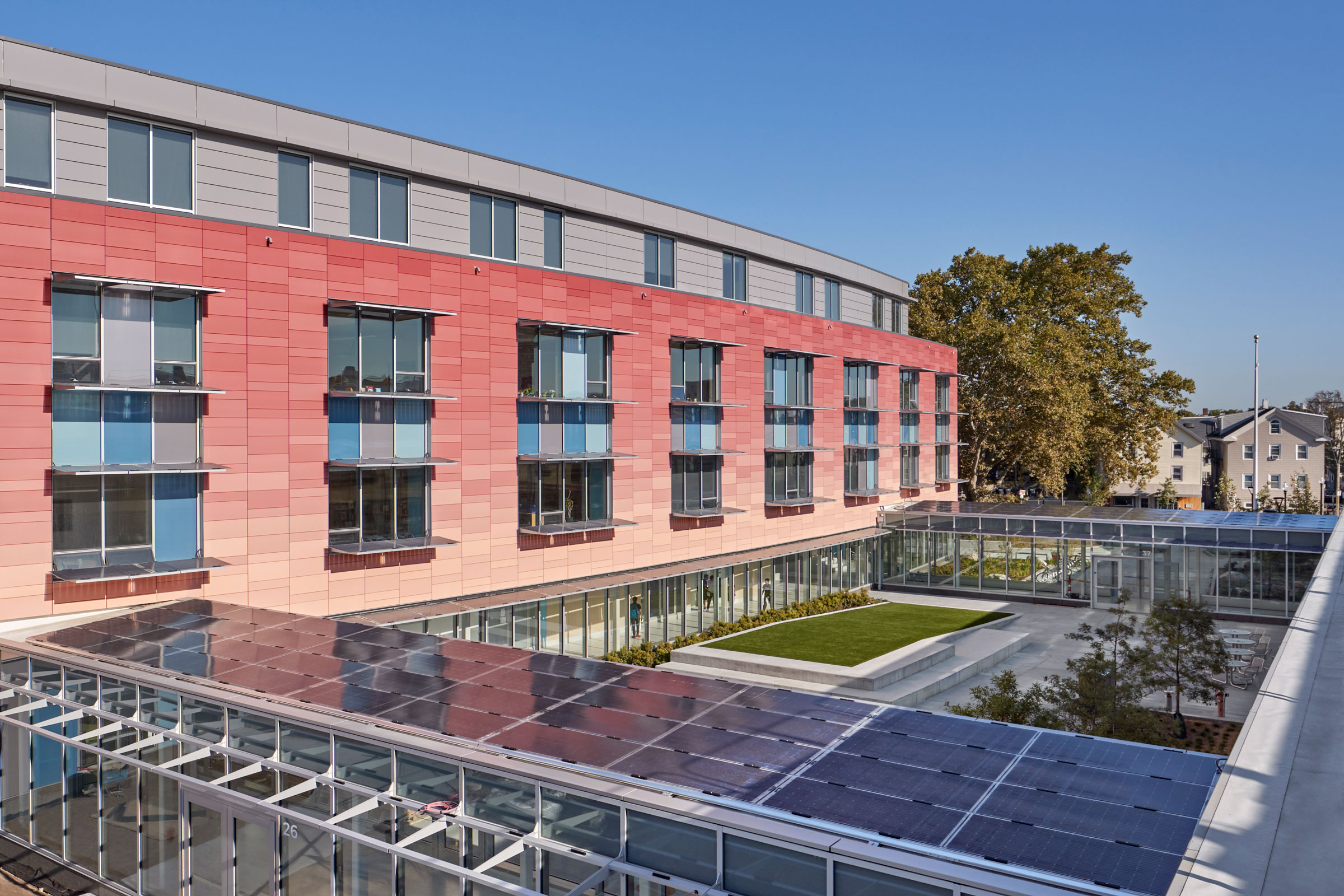Story at a glance:
- Geothermal energy is used for heating and cooling systems that are renewable, easily maintained, and affordable in the long run.
- King Open/Cambridge Street Upper Schools & Community Complex uses geothermal heating and cooling to reach net zero.
- Geothermal can be harnessed around the world and can even be used for electricity—especially at plate boundaries, where geothermal reservoirs are especially hot and porous.
While people have long taken advantage of the planet’s natural geothermal energy—think hot springs—geothermal heating and cooling is a relatively new invention, one that has only really been around for the last century. And while geothermal systems have largely caught on in Western European and Nordic countries, they are still considered relatively novel in the US.
In this article we provide an overview of geothermal heating and cooling—including how it works, the types of technologies, and the benefits and challenges—as well as explore a few project examples that implement geothermal energy.
What is Geothermal Energy?

Algaennovation, an international tech startup developing new technologies for producing micro-algae, gets all of its water and electricity from a geothermal power plant in Iceland. Photo by Ragnar Th. Sigurdsson
Geothermal energy describes any and all thermal energy extracted from the earth’s crust. It can be harnessed for heating, cooling, and clean electricity generation—the latter of which involves the drilling of deep wells to reach geothermal energy reservoirs and pump steam and/or hot water up to the surface. Using geothermal energy to generate electricity necessitates the construction of a power plant or multiple power plants above these natural geothermal energy reservoirs.
There are three basic types of geothermal power plants currently in use around the world: dry steam, flash steam, and binary cycle.
- Dry steam. Dry steam geothermal power plants are by far the simplest in design and are also the oldest type to be used by humans; these plants are located at sites where only steam, not water, is delivered to the surface; this steam (of 302℉ or hotter) is used to turn turbines, which in turn generate electricity as they rotate.
- Flash steam. Pull high-pressure hot water from deep beneath the surface to lower-pressure tanks, producing flashed steam in the process; this steam (of 360℉ or hotter) is then used to power a generator or turbine; any leftover water and condensed steam can then be injected back into the reservoir.
- Binary cycle. The newest type of geothermal power plants, binary cycle stations are capable of utilizing hot water at temperatures as low as 135℉; this hot water is passed by a secondary fluid that has a much lower boiling point than water, causing the fluid to flash vaporize, which in turn drives the turbines.
Large-scale power plants are not, however, required to harness geothermal energy for heating and cooling purposes. Instead these systems make use of a ground-source heat pump and the natural heat-transfer properties of earth and/or water.
Where is Geothermal Energy Best Used?
Generating electricity from geothermal energy requires hot water or steam, which is most accessible at tectonic plate boundaries where permeable hydrothermal reservoirs are present. This accounts for its popularity in places like Iceland and Japan, where underground sources of hot, easily accessible water are abundant, as well as Hawaii and the US West Coast, where geothermal energy resources are also relatively close to the surface.
Geothermal energy power plants become less viable—or at least, not as cost-effective—in regions where geothermal pockets are located further below the surface, requiring deeper and more intense drilling. Because geothermal heating and cooling technologies use heat exchanges in closed- or open-loop systems, however, they do not possess the same geologic requirements and can subsequently be utilized just about anywhere.
How Does Geothermal Heating & Cooling Work?
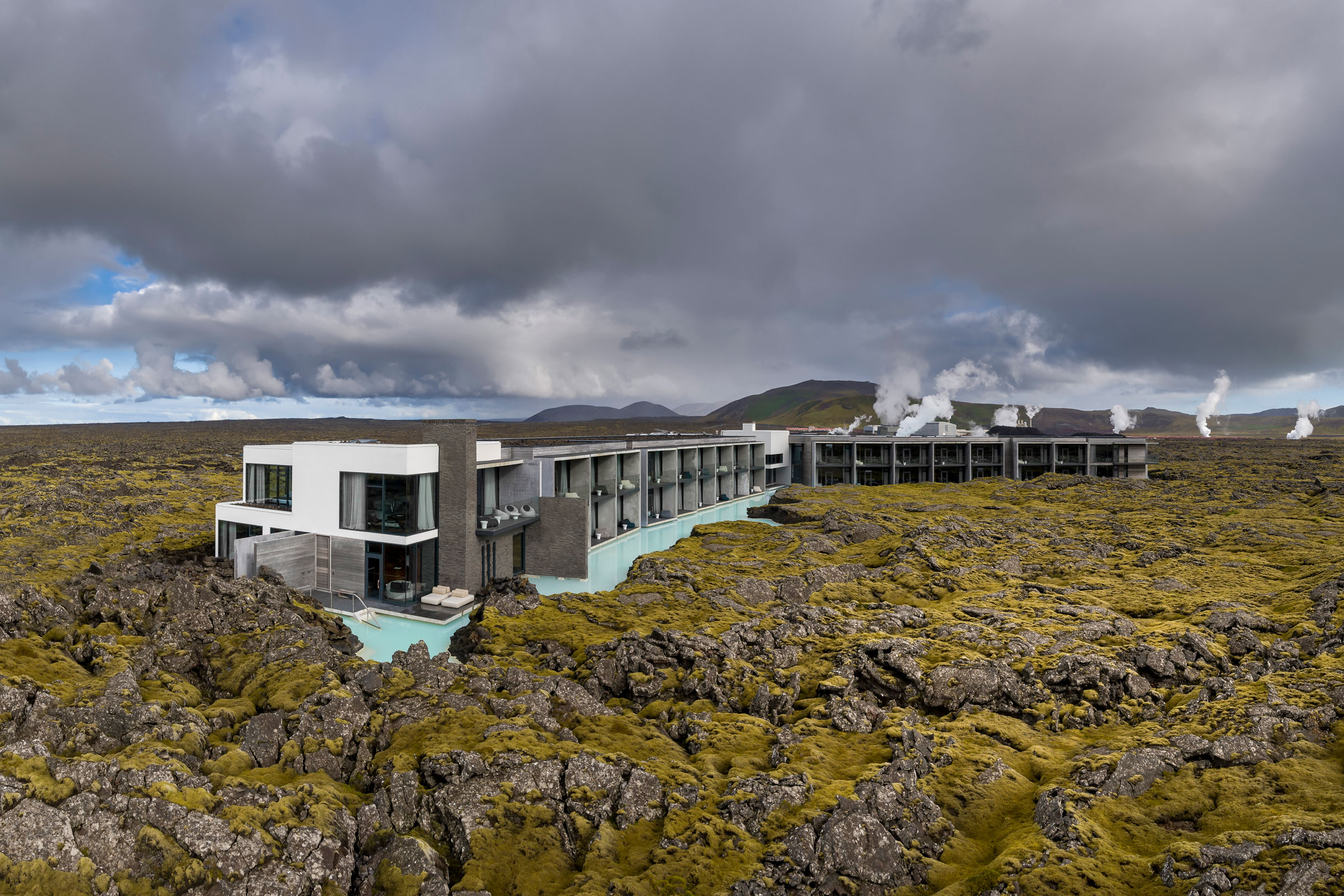
The Blue Lagoon is an otherworldly spa heated by a geothermal energy plant, and it’s many tourists’ first stop in Iceland. Basalt Architects, a leader in green building in Iceland, completed The Retreat at Blue Lagoon in 2018. Photo by Ragnar Th. Sigurdsson
In the practical sense geothermal heating and cooling refers to the direct use of geothermal energy for on-site heating and cooling applications. The most common and universally-applicable means of harvesting geothermal energy for heating and cooling is via a ground-source heat pump system. The heat pump itself acts as the heart of the system and is responsible for pumping a carrier fluid—typically consisting of water and an antifreeze agent like propylene glycol, denatured alcohol, or methanol—through a series of underground pipes and/or coils, where it either absorbs or transfers heat from/to the ground or groundwater.
During the winter months the cold carrier fluid is pumped underground where it is allowed to absorb heat from the ground/groundwater, which remains at a relatively stable temperature—40 to 50℉ (in northern latitudes) or 50 to 70℉ (in southern latitudes)—throughout the year. The now warm carrier fluid is then pumped back to the surface and enters the heat pump, which uses electricity to extract heat from the fluid and warm the building.
Geothermal cooling uses the same basic concept, just in reverse. During the hotter summer months, the carrier fluid absorbs heat from the interior air before being pumped underground, where that excess heat is then transferred to the relatively cooler earth or groundwater. Once cooled, the carrier fluid is then pumped back to the surface and used to create cool, dehumidified air conditioning.
Types of Geothermal Heat Pump Systems
There are four core types of geothermal heat pumps, three of which operate as closed-loop systems—that is, systems in which the pipes are only filled with a carrier fluid once, after which point the fluid is constantly recirculated throughout the system.
Vertical Closed-Loop

MSU Romney Hall makes use of a vertical closed-loop geothermal heat pump system consisting of 80 wells measuring 700 feet deep. Photo by Karl Neumann
A vertical closed-loop geothermal heat pump system consists of several “wells” or bore holes drilled deep into the earth and spaced at least 16 to 20 feet apart. Each well is fitted with a U-shaped pipe that circulates carrier fluid, absorbing or discharging heat from/into the earth and pumping the warmed/cooled fluid back to the surface. Depending on the type of building, pipes may even be integrated with the foundation piles.
Vertical closed-loop geothermal systems are best suited to highly urbanized areas where there is limited land available, as the installation process is fairly non-intrusive compared to some other types of geothermal systems.
Horizontal Closed-Loop
Horizontal closed-loop systems, on the other hand, consist of a series of U-shaped or slinky pipes/coils buried in long, extensive trenches dug deeper than the frost line, typically around six to eight feet deep. From an operational standpoint horizontal closed-loop systems function identically to vertical closed-loop systems.
These horizontal closed-loop systems are ideal in areas where ample land is available for the digging of trenches and in regions with wetter ground, as water conducts heat better than soil particulates, which in turn improves system efficiency. The addition of buried soaker hoses, however, can make horizontal geothermal systems viable even in areas with naturally dry soil.
Pond Closed-Loop
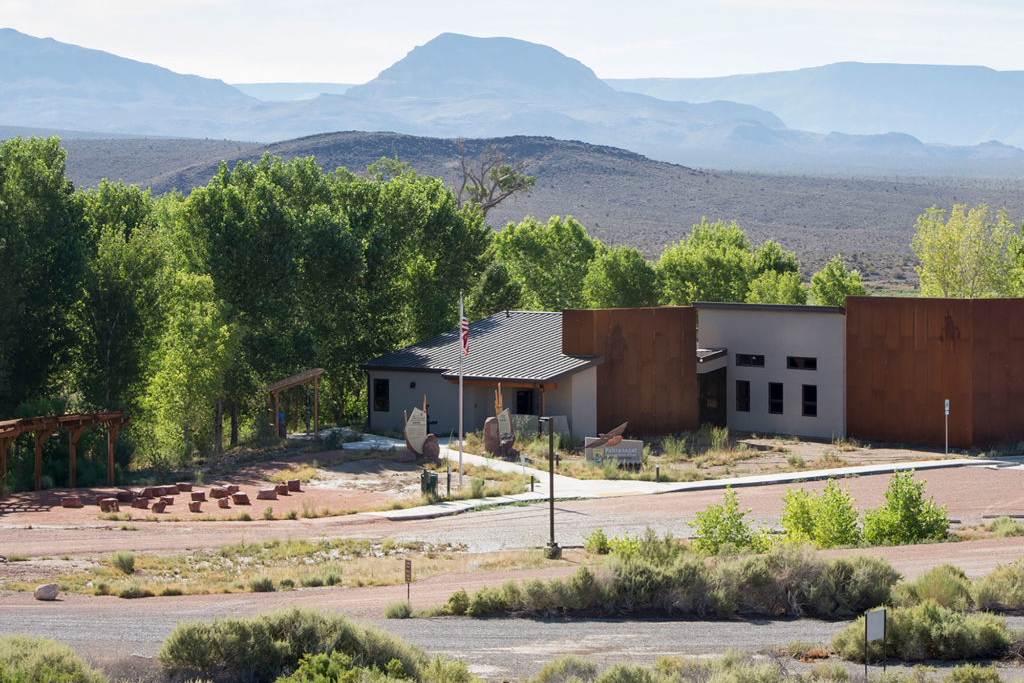
The Pahranagat National Wildlife Refuge Visitor Center in Nevada is a net zero building that features a pond closed-loop geothermal heating system. Photo courtesy of Cushing Terrell
Pond closed-loop geothermal systems are similar in layout to horizontal closed-loop systems and pump carrier fluid through underground pipes into a series of coils submerged in a nearby pond or lake of sufficient size, depth, and flow. Rather than use the earth itself to heat or cool the carrier fluid, however, pond closed-loop systems use the water body as a heat source and heat sink. For a geothermal pond closed-loop system to be viable, the water body in question must be at least a half-acre in size and approximately eight feet deep.
The Pahranagat National Wildlife Refuge Visitor Center in Nevada makes use of a pond closed-loop geothermal system to supply heating and cooling throughout the year. Combined with roof-mounted solar photovoltaic panels the ground-source heat pump helped the center achieve net-positive energy status, allowing the building to produce almost twice as much energy as it uses annually.
Open-Loop
An open-loop geothermal system, on the other hand, pumps clean groundwater—as opposed to a carrier fluid—from a nearby aquifer or reservoir to an indoor geothermal heat pump. Once the water leaves the building, it is either expelled via a discharge well or dumped into a nearby pond or drainage ditch (if approved by local codes). Over the last several decades many municipal governments have made the dumping of open-loop systems illegal, though most still permit re-injection back into the aquifer.
Because they require no trenching or drilling, open-loop geothermal systems are typically the least expensive to install, though they are much more susceptible to degradation and corrosion caused by changes in water chemistry. Open-loop systems also possess more stringent location requirements than closed-loop systems, as not all regions have enough groundwater to reliably supply the loop with water throughout the year.
The Benefits of Geothermal Heating & Cooling
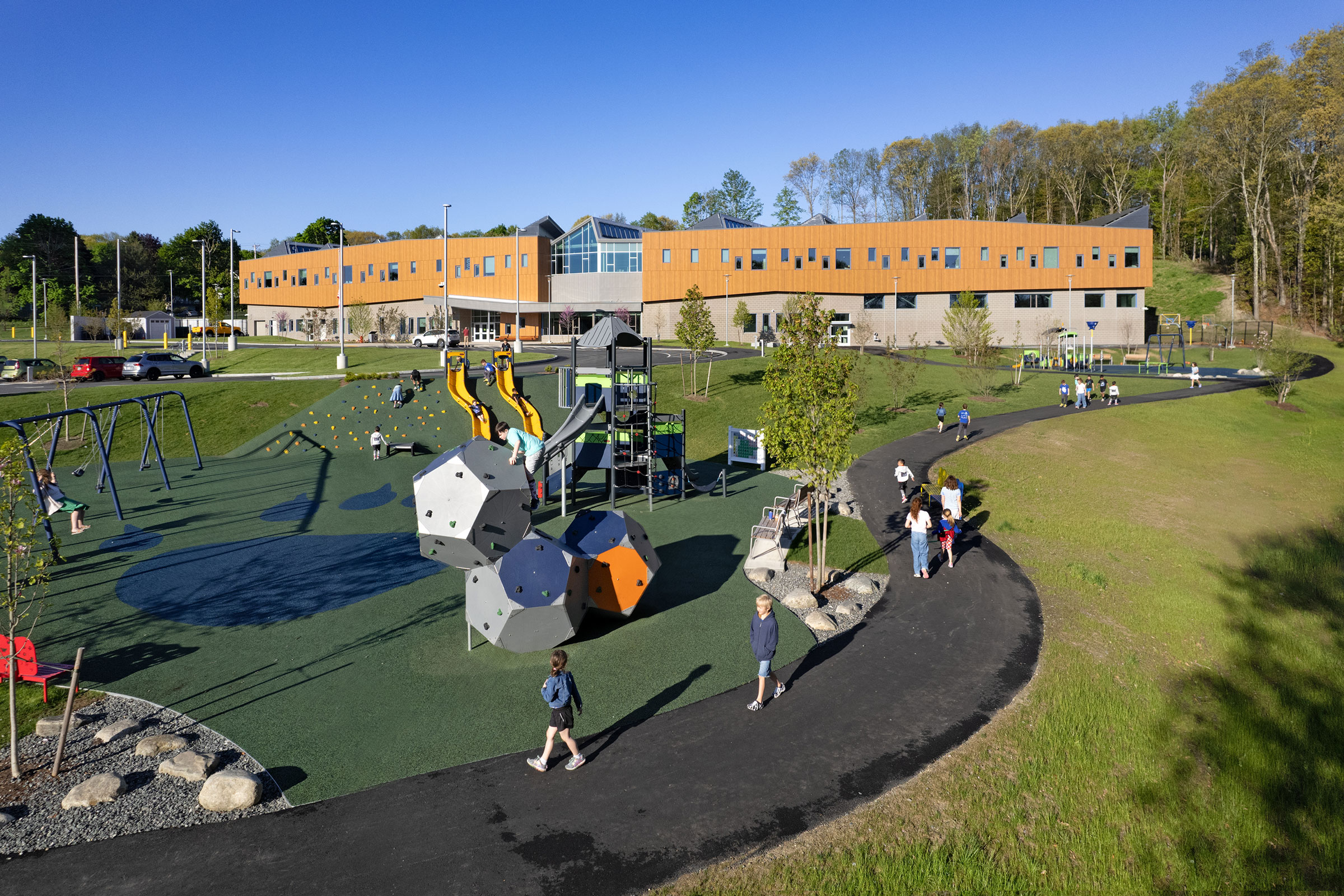
Annie E. Fales Elementary School uses a high performance geothermal heat pump system and other energy reduction/energy-efficiency measures to greatly reduces its energy consumption and carbon footprint. Photo by Ed Wonsek
There are many benefits associated with the integration of geothermal heating and cooling into a building’s design, some of which include:
Environmentally Friendly & Energy-Efficient
One of the core benefits of geothermal heating and cooling systems is that they are much more environmentally friendly than traditional boilers and furnaces, as they do not burn fossil fuels to produce heat.
Of course, a geothermal heat pump may still be responsible for some greenhouse gas emissions if the electricity used to run it was generated via the burning of fossil fuels, but even then they are still more sustainable than conventional ducted HVAC systems—and geothermal heat pumps powered entirely by electricity generated by renewable energy sources like solar or wind power will not produce any emissions at all.
This is thanks to the fact that geothermal heat pumps are extremely efficient, often operating at 400% or more efficiency, meaning they are capable of converting one unit of electricity to four or more equivalent units of heating or cooling. To put that into perspective, most furnaces, boilers, and ducted HVAC systems operate at below 100% efficiency. This improved energy efficiency then translates to reduced operating costs, helping homeowners and building owners save on their utility bills—oftentimes by as much as 40 to 50%.
Low Maintenance & Long-Lasting
Once installed geothermal heat pump systems—especially closed-loop systems—require very little ongoing maintenance over the course of their operational lifespans. Compared to traditional HVAC systems geothermal heat pumps have few moving parts that may break or wear out over time. That’s not to say that regular maintenance isn’t necessary when it comes to geothermal heating and cooling, with most experts recommending an annual maintenance check-in during the fall to ensure that all parts are working properly.
As long as they are properly taken care of, the indoor components of geothermal heat pump systems—that is, the parts of the heat pump itself—have an average lifespan of 20 to 25 years, whereas the outdoor in-ground components are typically designed to last 50 years or more before needing to be replaced.
Unaffected by Surface Conditions
Another benefit of (most) geothermal technology is that it can’t be affected by extenuating surface conditions like weather or climate patterns—pitfalls of both solar panels and wind turbines, as well as, to some extent, hydropower dams. This makes geothermal energy a consistently reliable source of heating and cooling throughout the year.
The only types of geothermal heating and cooling system that are affected by climatic conditions are pond closed-loop and open-loop systems, as both require adequate rainfall to remain viable, lest the pond or aquifer run dry.
Challenges of Geothermal Heating & Cooling
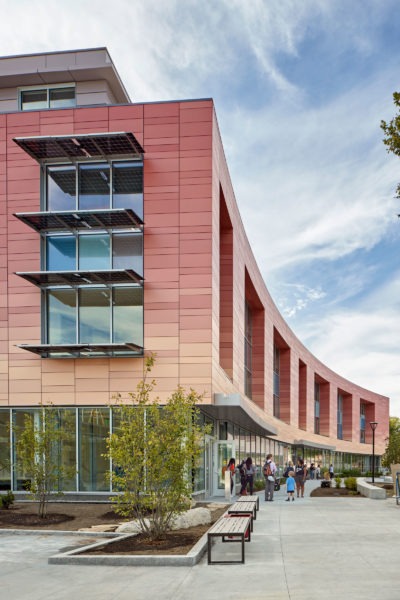
Geothermal heating and cooling boasts many benefits, but it also comes with high upfront costs. Courtesy of William Rawn Associates
Just like any energy source—renewable or otherwise—geothermal heating and cooling is not without its challenges.
High Upfront Costs
As with many green energy technologies, the biggest challenge of geothermal heating is the high upfront costs it comes with compared to traditional heating and cooling systems. Depending on the scale and type of geothermal heating system in question, procurement and installation costs can average anywhere between $10,000 to $25,000 for a single-family residence, though expenses can range as high as $50,000.
Can Be Invasive
While not true of all geothermal heat pump technologies, certain systems—particularly horizontal and pond closed-loop systems—can be incredibly invasive, requiring significant alterations to the surrounding landscape during their installation. This is especially true of geothermal heat pumps being installed in existing residential contexts, as it requires a portion of the yard be either dug up to lay down coils or drilled into to put in pipes.
May Be Site-Dependent
Though very rare, some homes and buildings are simply not suited to geothermal heat pump systems, with the most common reason being inadequate space for drilling—which is already the least-invasive method for installing geothermal heating and cooling. This is primarily due to the fact that geothermal heat pumps have to be uniquely tailored to each site in which they are installed and geothermal technology is not as easily adapted from site to site as other forms of renewable technologies like solar panels.
When is the Payoff for Geothermal Energy?

The King Open/Cambridge Street Upper Schools and Community Complex saw an almost immediate return on their geothermal heating system. Photo courtesy of William Rawn Associates
As we’ve already learned, geothermal heating and cooling systems are both a big investment and a long-term source of savings. But just how quickly do these systems pay for themselves? The short answer is that it depends on a variety of factors, with location, scale, type of system, and usage patterns being the most influential. On average, however, geothermal heat pumps typically pay for themselves within 10 years, though the payoff can be much sooner, too.
The King Open/Cambridge Street Upper Schools in Massachusetts, for example, saw returns on their geothermal wells within less than two years following their opening. “The technologies needed to design the building to net zero, including geothermal wells and photovoltaics, were less than a 1% increase in construction cost,” Kate Bubriski, director of sustainability and building performance and an architect at Arrowstreet—one of the firms that helped design the project—told gb&d. “The significant operational savings from the low energy building and onsite photovoltaics make the return on capital investment fairly immediate.”
3 Projects That Use Geothermal Heating
Now that we’ve a better understanding of what geothermal heating is, how it works, and its benefits, let’s take a look at a few projects that have successfully used geothermal power to reduce their carbon footprints.
1. Annie E. Fales Elementary School, Westborough, MA

The HMFH-designed Annie E. Fales Elementary School used solar photovoltaic panels, a large geothermal heating system, and other sustainability features to achieve net-positive status. Photo by Ed Wonsek
As the first net-positive energy public school in New England, the Annie E. Fales Elementary School blends sustainable and educational design to foster a sense of environmental and social responsibility in young students from an early age. Designed by HMFH Architects, Annie E. Fales Elementary School is the first completed facility to support Westborough’s goal to become carbon-emissions free by 2050 and boasts net-positive status—a feat achieved in large part via the integration of solar photovoltaic panels and geothermal power.
Consisting of 40, 600-foot deep, High Performance Geo Exchange (HPGX) wells all connected to a central geothermal vault, the school’s geothermal field connects supply and return lines to water-to-water ground source heat pumps located within the building’s mechanical room. The geothermal system utilizes concentric pipes to circulate a propylene glycol carrier fluid solution, the unique shape helping to minimize frictional pressure drop, which in turn reduces the electricity required to operate the pumps themselves.
A reversible MultiStack chiller delivers a peak heating load of 158 tons (1,900 MBtu) and peak cooling loads of 160 tons (1,920 MBtu), while a separate 30-ton heat recovery chiller is used to heat the school’s domestic hot water.
2. MSU Romney Hall, Bozeman, MT
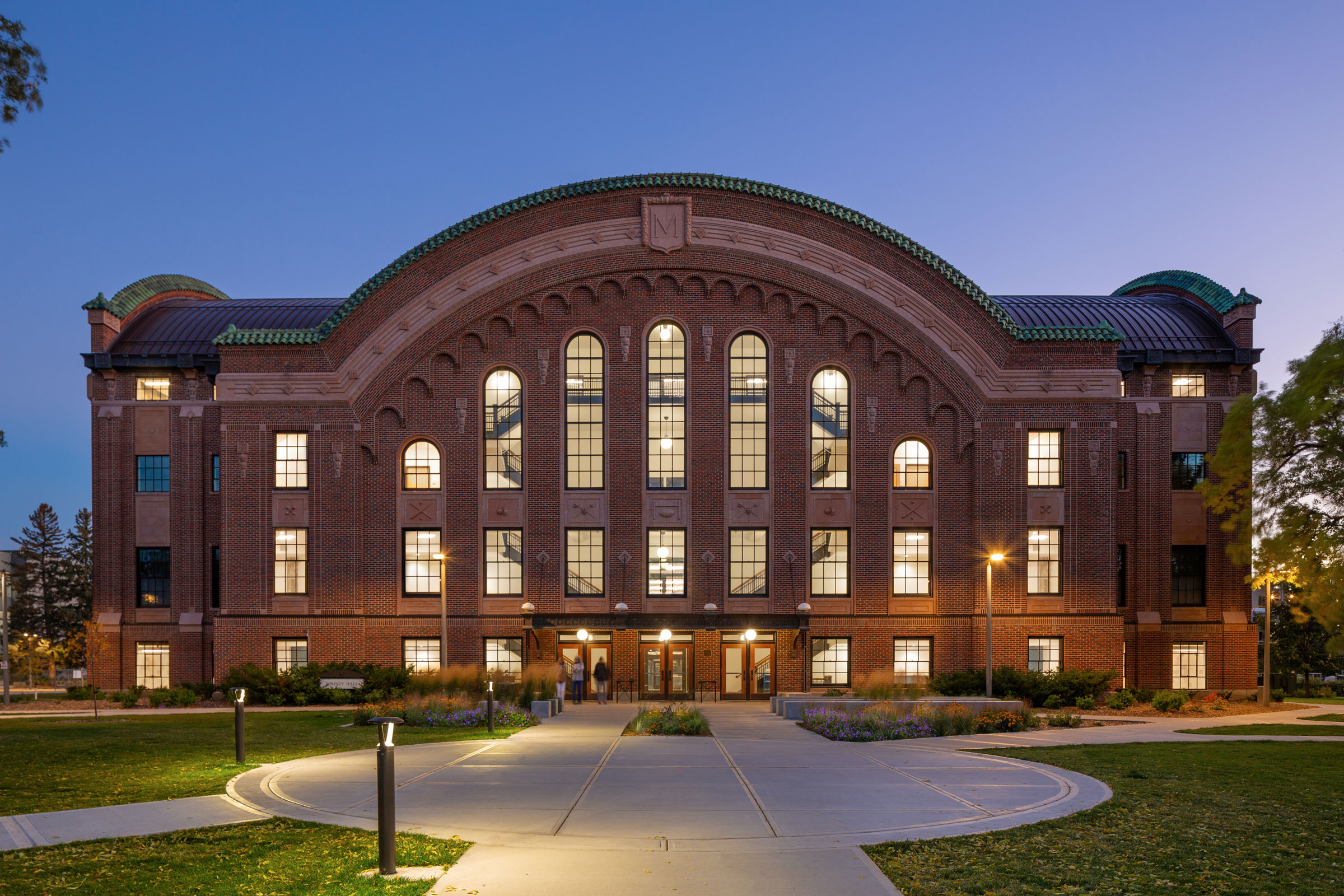
MSU Romney Hall is now serviced by a geothermal field consisting of 80 vertical closed-loop geothermal wells. The field acts as a giant battery and stores heat for later use. Photo by Karl Neumann
Originally built in 1921 as a physical education building for Montana State University (MSU), Romney Hall largely fell out of use in the 1970s after the university constructed new athletic facilities. Rather than tear the building down, however, Romney Hall was renovated and updated by Cushing Terrell, whose project goals included preserving the building’s Italian Renaissance Revival style while simultaneously improving accessibility, safety, and sustainability—the latter of which is achieved in part through the integration of geothermal power.
Constructed in an open space just north of the building, Romney Hall’s geothermal field consists of 80 vertical closed-loop boreholes measuring 700 feet deep. All of the pipes used in the system are encased in a special grout and serve to circulate a carrier fluid that stores excess heat extracted by the hall’s ventilation system, to be reused later on to heat the building. The boreholes are also designed to store heat from the hall’s south-facing “solar wall,” which converts sunlight to heat.
Inside, almost 40 heat pumps are used to transfer heat to and from the geothermal system. Romney Hall is the campus’ seventh building to implement geothermal heating and connects to the nearby geothermal field at Norm Asbjornson Hall, creating what’s referred to as an energy district and greatly reducing the energy demand of both buildings.
3. King Open/Cambridge Street Upper Schools, Cambridge, MA
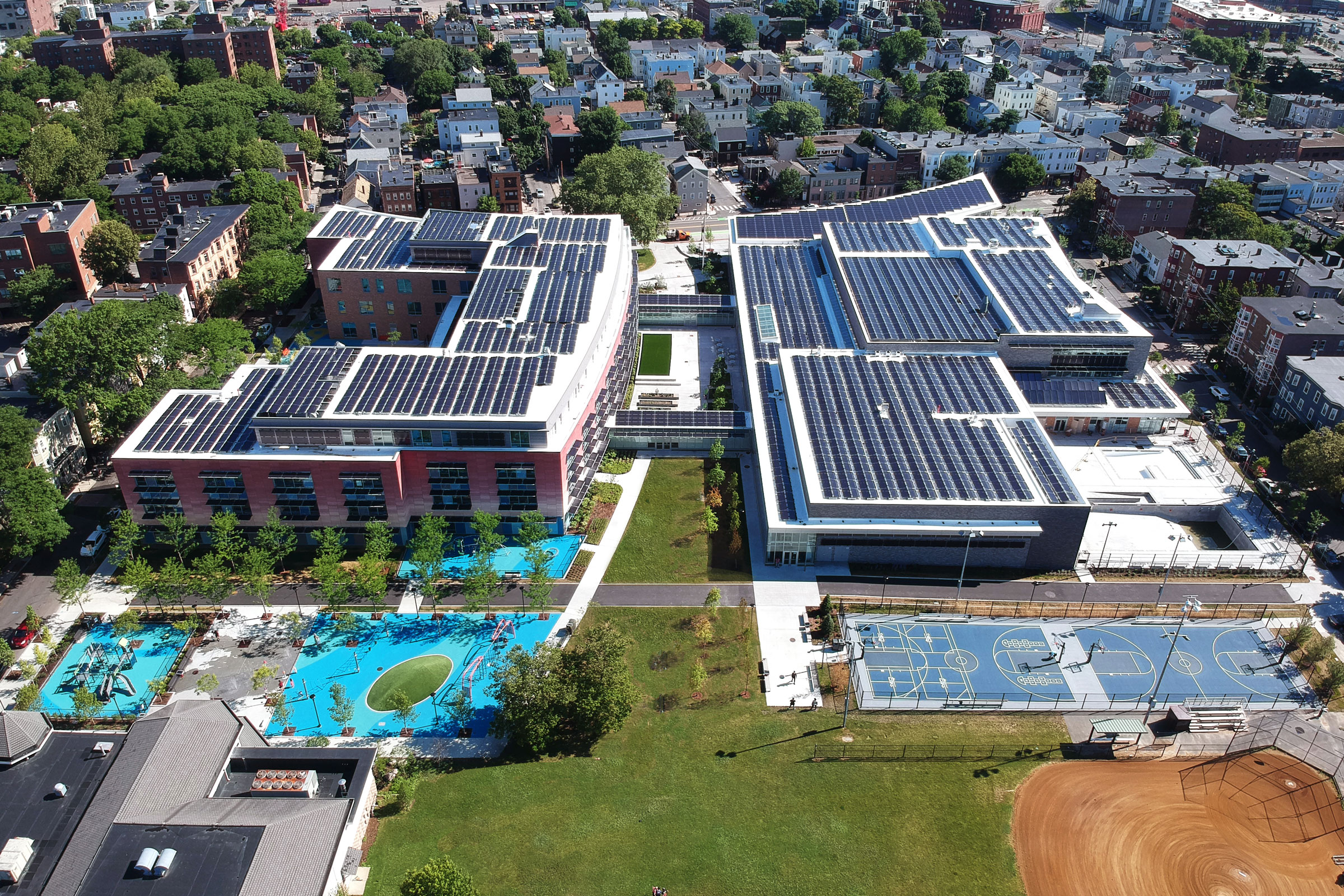
King Open/Cambridge Street Upper Schools & Community Complex—designed by Arrowstreet along with William Rawn Associates and the City of Cambridge—features a large geothermal field consisting of 190 wells. Courtesy of William Rawn Associates
In an impressive community complex that houses administrative offices, a library, a public pool, and two schools, Arrowstreet, along with William Rawn Associates and the City of Cambridge, built Massachusetts’ first Net Zero Emissions school. The project, King Open/Cambridge Street Upper Schools & Community Complex, is an integral part of the city’s Net Zero Plan, which aims to attain carbon net zero throughout the city in just 25 years.
The school building uses 70% less energy than the average school in the US and 43% less energy than a typical Massachusetts school that meets the state’s energy code. “The project goal was to achieve Net Zero emissions, which means that the building systems are all-electric and the building has an ultra-low Energy Use Intensity,” says Bubriski. Accordingly, the building combines several forms of clean energy and energy-reducing technologies, including a geothermal heating and cooling system.
Bubriski says the Arrowstreet team chose geothermal wells for the school because “ground source heat pumps were the most efficient system and have reliable maintenance and durability.” Geothermal technology is proven, and sooner rather than later it also yields a substantial return on investment.
The schools utilize a closed-loop heating and cooling system in which 190 geothermal wells—each bored 500 feet deep—supply a heat transfer fluid to electric heat pumps. Heat exchangers at the pumps extract or release heat from the geothermal well loop depending on the season, and from the heat pumps hot and chilled water lines supply radiant heating and cooling panels throughout the building, including the air handling units that support the displacement ventilation system.
Lark Breen contributed to this article.

